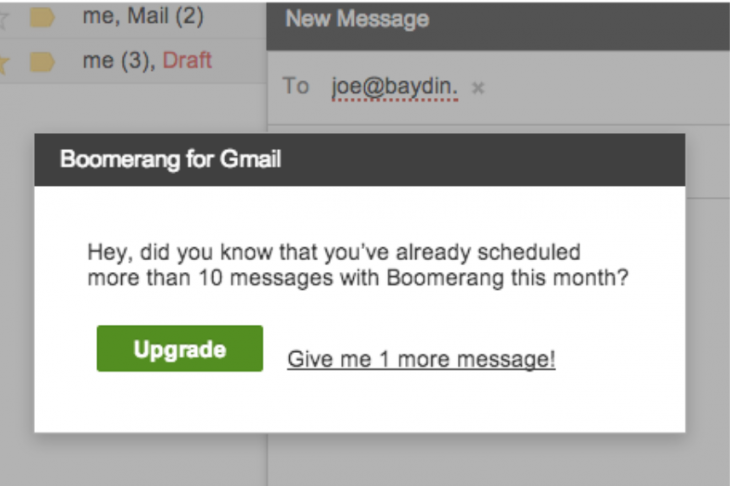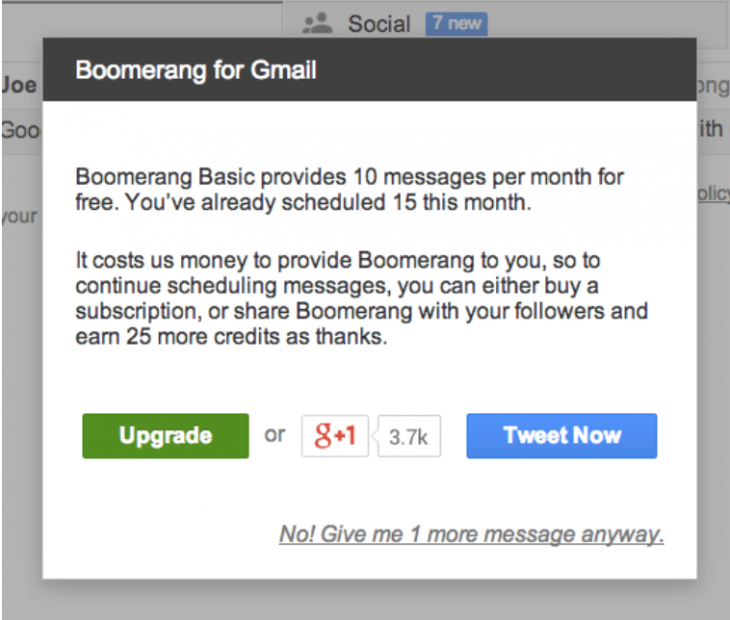
Aye Moah is the Chief of Product and co-founder of Baydin, an email productivity company.
A few weeks after releasing Boomerang for Gmail to the world, we started receiving inquiries from our users asking how they could donate some money or “tip us” in appreciation of our hard work. We also heard from users who insisted they wouldn’t rely on a free tool as part of their email workflow — after all, free tools disappear all the time!
Around the same time, our investors and our company accountant started asking us how we planned on feeding ourselves. Putting two and two together, we decided to turn Boomerang into a freemium product that would provide us with revenue to be a sustainable company. With that revenue, we hoped we might be able to afford a bit more nutritious sustenance than instant ramen noodles.
This issue – how to begin actually making money – is one that every tech startup will face at some point. We, like many startups before us, decided on a freemium model of granting product capabilities to users up to a certain point, and then implementing a paywall to access unlimited usage and premium features.
That’s where the similarities stopped.
Typical paywalls create a divide between company and customers, but we found that a mix of flexibility, humor, and a personal touch drove user retention and fostered love for the brand, while still converting users into customers at a high rate and generating meaningful revenue.
Here are some tips on how to keep your users coming back, while ensuring you get more “pay” and less “wall.”
Avoid building a harsh barrier and keep it porous
The worst thing you can do with a paywall is take the term “wall” too literally. You don’t want your paywall to figuratively smack them in the face as they are trying to accomplish something with your product.
Traditional paywalls provide exactly this experience – users are stopped in their tracks once they reach the free usage limit. No wiggle room, no negotiation, no expression of understanding for how much they’ve already emotionally committed to the service.
This rigid structure can make people feel like they have no other choice but to leave and never come back. And even if they choose to pay, the experience of having their workflow interrupted by a demand for money leaves them unsatisfied.
Instead, design your paywall experience with a focus on making your users feel as if they are being invited to be a part of a great thing by paying a small fee. Not that they are being shut out and turned away if they don’t pay.
The word “wall” makes everyone think of an obstacle, and you don’t want your users feeling as if something is standing in their way. Encourage them to climb it, enjoy the discovery that lies on the other side… and maybe have some fun along their journey.
How we did it
We started by offering a 30-day free trial. This gives the user an opportunity to try out the service with absolutely no restrictions on the features or the number of messages they can schedule for a set period of time. That way, users can fully test the product without feeling the pressure of an impending usage limit.
At the end of the trial, if they never use beyond the free message quota every month, they can happily continue as free users as long as they wish. We only want to charge users who are getting enough value out of our service to justify a subscription.
Every time they schedule a message beyond the free limit, they see a pop up that gives them the option of staying as free users along with the option to upgrade to a paid plan. It gives them advance notice that they are over the limit, technically, but that we will let them keep going just this once. The nudges become more and more firm, conditioning them for the eventual final limit.
Money isn’t the only currency
Naturally, you’re going to have some users that just won’t pay for your service. Maybe they truly can’t afford it, maybe they are stubborn and don’t believe in paying for software, or maybe they just want to use the service a bit more before making a commitment.
Whatever the reason, you can still negotiate for some other form of value besides cold, hard cash.
To accommodate those types of users who just won’t pay, find ways where both sides can help each other. If a user isn’t yet willing to pay to gain access to more services, give them opportunities to earn some by sharing your product. They get to keep using without having to pay and you get a warm introduction to new potential customers.
How we did it
We allow users to earn more usage by inviting friends and family to sign up for our service. They can also earn more usage for posting about us on social media.
Not only is this great promotion for the product, but it has the potential to bring in prospective paying customers. And after a couple more months of using the product for free, your non-paying customer may become so enamored with your service that they open their wallets later!
Personality is a plus
It’s not surprising that asking your customers to open their wallets to pay for a service that they’ve been using for free can cause frustration. The key here is to not come off as a nameless, faceless, greedy corporation more concerned with making money than user happiness.
Adding some personality into your paywall can go a long way toward diffusing these tensions. Use language that is personable and relatable to put yourself on the same level as your users – remind them that you aren’t some giant company chasing their dollars to pump stock prices; you’re just a group of folks, building this product for a living, and you’d like to continue to provide a great service with their support. You’re not the cable company!
How we did it
We really wanted our users to feel like they knew us as people. We also like to inject some humor and have a little fun. We even used a limerick to get a laugh. The following limerick is used to communicate to users that they have sent their final free message and they would have to upgrade to continue using the service.
“Our dinner is not steak and fondue
Instead it is Ramen and stew
If users don’t buy
We’ll starve and die
So no more messages for you!”
And in return, our customers have replied to us with their own limericks. Then after hitting the paywall a few months in a row without a bad taste in their mouth, they are more likely to sign up and pay for it because the humor and the personality of our paywall implementation painted us as regular people.
No more ramen noodles for dinner
If you are thinking about how to implement a paywall or improve an existing one for better conversion while nurturing a better relationship with your users in the process, just keep in mind how you would feel in your users’ situation.
How would you want to be approached for money? How would you react if your usage was just completely cut off? Your users likely have enough services and products clamoring over their hard earned dollars – you don’t want to come off as another logo just trying to grab a buck. You want to build a relationship with them as you are asking them to pay for your product.
So if you’re ready to turn your free product into a revenue generator (and maybe upgrade your dining options in the process), use these tips to turn your paywall into a cash windfall. As for us, while we are still not bathing in champagne, we only eat instant ramen for dinner when we are feeling nostalgic!
Get the TNW newsletter
Get the most important tech news in your inbox each week.


